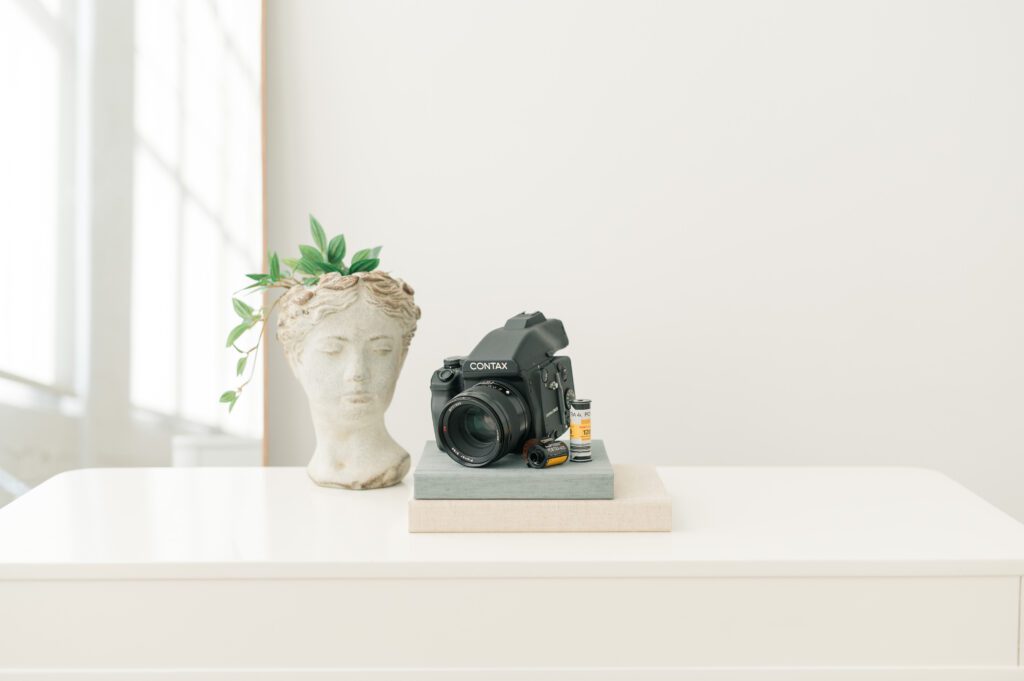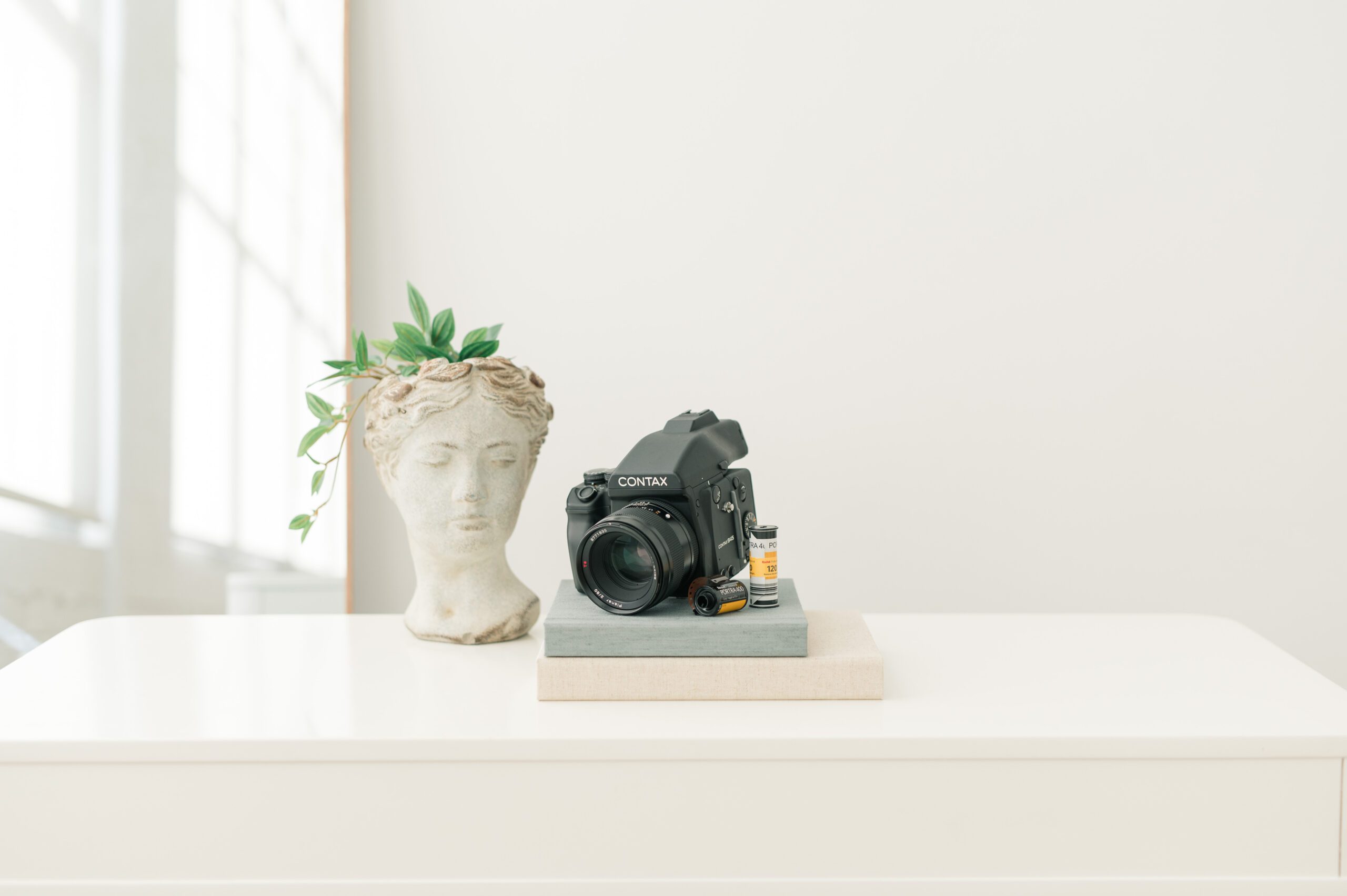The Difference of Film Wedding Photography
February 8, 2025

Growing up with a camera in hand and film negatives all around, I can wholeheartedly say that there is a unique, nostalgic quality to film photography that simply cannot be replicated. For the lovers of memories and tangible keepsakes (like me), film wedding photography may be the best choice for your celebration. Let’s review how it can make a difference in your memories and what separates it from conventional digital photography.
But first, what is film photography?
At the heart, film photography is a manual (or analog) form of photography. And while it wasn’t the first type of photography (that would be the daguerreotype), it has been capturing memories far longer than its digital counterpart.
Since the late 19th century, most photographs were created with rolls of film that captured images when exposed to light. The cameras were manually focused and loaded. This craft was not only much more analog, but it also required more skill and precision than an auto-focusing digital camera does today.
So, how does film wedding photography work?
Whereas a digital camera can capture a scene with nothing more than a memory card and a quick autofocus, film photography involves a few more steps and measurements to capture a moment well. When capturing film, your wedding photographer (that’s me!) will load their camera with a roll of film prior to a big moment, measure the light of the space with a light meter (to manually understand how to expose the image), set the shutter speed, focus the lens, and then intentionally frame the scene at hand. When the shutter button is clicked, the film is briefly exposed to the light and the image is captured.
When your event is over, your wedding photographer will then take all used rolls of film and send them to a photo lab. There, the film is developed in a dark room with a series of chemical baths. Finally, the images are scanned and sent to a digitized gallery. Typically, you will receive the digital scans of the film images with your online wedding gallery while the negatives are kept by your photographer or the photo lab.
Since this process is lengthier, it may take a bit longer to receive the final images. But trust me, they’re always worth the wait and building anticipation.
Oftentimes, wedding photographers use the true-to-life colors of the film images to accurately edit the digital photos. You won’t usually be able to tell which image was on film and which was on digital, unless, of course, a more grainy film style was used.
Digital vs film photography and the impact on your wedding imagery
Both mediums have their benefits and challenges, so let’s compare the difference between digital and film photography for your wedding so you can see the impact.
Digital wedding photography
- High resolution with crisp image quality
- Distinct style preferences can be met with editing software
- Photo quantity is virtually unlimited thanks to memory cards
- Able to capture fast-paced moments with clearer images
- Weather and lighting conditions have less of an impact
- Faster delivery time
Film wedding photography
- Final photos have a texture that is unique to each frame
- The overall colors are often more true-to-life without editing needed!
- Best at capturing intimate and slow-paced moments
- Limited number of photographs per roll (usually about 16 images on medium format film and 36 on 35mm)
- Intentional, artistic process
- Weather and lighting will impact availability
- Longer development time
- Nostalgic and classic
How film photography can be incorporated into your wedding
The use of film photography throughout your wedding is often dependent on your wedding photographer’s creative process. When I am documenting a wedding, I incorporate film as much as possible over the course of the celebration.
For key moments of the wedding, like getting ready in the morning, the ceremony, and formal portraits, I prefer to use medium-format film. Medium format is great for these moments due to its higher resolution, sharper details, and subtle texture. The need to slow down (since the number of photographs are limited per roll) leads to a more mindful storytelling approach — for the artist and for the wedding couple. Film also has a nice, deep contrast and sometimes a light grain that is gorgeous!
Digital will be best for the fast-paced moments like the cocktail hour and reception. However, for a nostalgic flair, you’ll find me incorporating a few 35mm frames. These are known for a grainier look and a broader depth of field, allowing larger scenes to be captured at once.
Why I love wedding photography on film (and why you’ll love it too)
Although digital photography is reliable and will always be a staple of my photography process, digital images can often lose the authenticity of the moment at hand. Since every photo can be edited to perfection (or way beyond what the moment actually looked like), not every image will be a true-to-life representation. The best thing about film photography is that it beautifully embraces the imperfections of the emotions and memories it captures. Because editing is less prevalent with film, you’ll be able to look back at these captures and relive them almost exactly as they happened.
And with film limiting the number of photos you can take at once (you can’t just hold the shutter and take an infinite amount of photos — the roll of film will literally run out and you need to advance the film roll), you have to take it slow and think through every image you capture.
Considering film wedding photography for your memories?
Film photography has become an integral part of my process as a wedding photographer in New England. All coverage includes film for a collection of imagery that is both classic and nostalgic. Get in touch to talk about the ways we can incorporate film into your wedding.
Related
©2025 NICOLE CERRUTO | ALL RIGHTS RESERVED | PRIVACY POLICY | Site Credit
